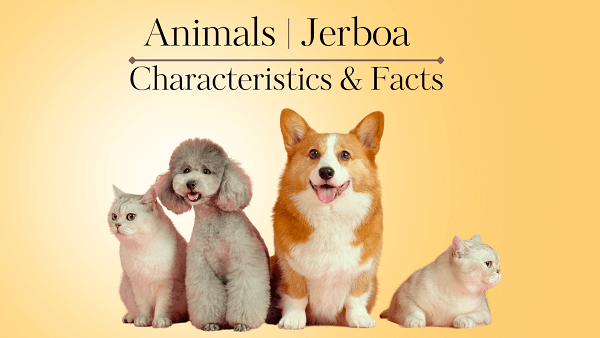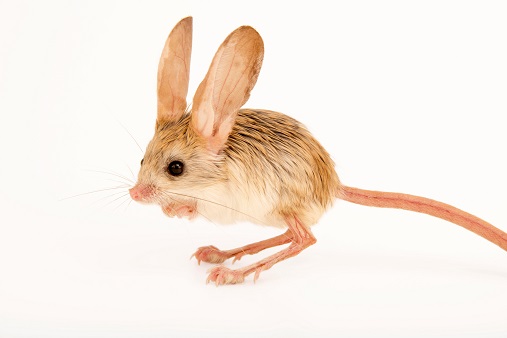Jerboa Definition
A jerboa is a small rodent that belongs to the family Dipodidae. These creatures are known for their unique and distinctive adaptations that allow them to thrive in arid and desert environments. Jerboas are primarily found in the deserts of Asia and Africa.
Jerboa General Characteristics & Facts
Size and Appearance
Jerboas are small rodents, typically ranging in size from 2 to 6 inches (5 to 15 centimeters) in length, excluding their tails. They have a unique appearance with long hind legs and feet, short front legs, and a long tufted tail. Their body coloration varies among species, with shades of brown, gray, or yellow.
Adaptation to Desert Environments
Jerboas are well adapted to arid and desert environments. Their long hind legs and feet are designed for efficient hopping, enabling them to move quickly across sandy terrain. They have specialized kidneys that enable them to conserve water by producing highly concentrated urine.
Nocturnal Behavior
Jerboas are primarily nocturnal, being most active during the night. They are well-suited to this lifestyle, as it allows them to avoid the intense heat of the desert during the day.
Unique Jumping Ability
Jerboas are known for their remarkable jumping ability, which they achieve using their powerful hind legs and feet. They can cover distances of up to 10 feet (3 meters) in a single jump, allowing them to quickly escape from predators and search for food.
Diet
Jerboas are omnivorous, although their diet primarily consists of seeds, grains, insects, and vegetation. They have adaptations for consuming a variety of foods, including sharp incisors for cracking open seeds and strong jaws for consuming insects.
Communication
Jerboas communicate with each other through vocalizations and drumming their feet on the ground. These foot drumming sounds serve as warning signals to other jerboas and help maintain territory boundaries.
Species Diversity
There are several different species of jerboas found in different regions of Asia and Africa. Each species has specific adaptations and characteristics that enable them to survive in their respective habitats.
Reproduction
Jerboas have a short breeding season, typically occurring in the spring or summer. Females give birth to relatively small litters of one to six offspring. The young are born in a relatively advanced state, with their eyes open and the ability to move around shortly after birth.
Physical Characteristics of Jerboa
- Size: Jerboas are small rodents, typically measuring between 2 to 6 inches (5 to 15 centimeters) in length, excluding their tails.
- Body Shape: Jerboas have a unique body shape characterized by long hind legs and feet, short front legs, and a relatively long tail. This body structure enables them to move quickly and efficiently hop across the desert terrain.
- Limbs and Feet: The hind limbs of jerboas are significantly longer than their front limbs. They have elongated metatarsal bones and specialized foot structures, including elongated digits and large hind feet. These adaptations allow them to perform powerful jumps and maintain balance while navigating sandy surfaces.
- Tail: Jerboas have a long and slender tail, which is often longer than their body length. The tail serves various functions, including providing balance during hops and aiding in communication and thermoregulation.
- Head and Ears: Jerboas have relatively large heads in proportion to their body size. They possess rounded ears, which are large and sensitive to detect sounds and vibrations in their environment. Their large eyes provide good vision, particularly in low-light conditions.
- Fur and Coloration: Jerboas have dense fur covering their bodies, which helps insulate them in extreme desert temperatures. The coloration and patterning of their fur can vary among species but often includes shades of brown, gray, or yellow, allowing them to blend into their natural habitats.
- Teeth: Jerboas have sharp incisors and molars adapted for their omnivorous diet. Their incisors are specialized for cracking open seeds and nuts, while their molars help them chew plant material and insects.
Continue To Explore All Animals That Start With J
Scientific Classification of Jerboa
Kingdom: Animalia (Animals)
Phylum: Chordata (Chordates)
Class: Mammalia (Mammals)
Order: Rodentia (Rodents)
Family: Dipodidae (Jerboas)
Key Locations of Jerboa
- Egypt
- Libya
- Sudan
- Niger
- Chad
- Mali
- Mauritania
- Algeria
- Morocco
- Tunisia
- Western Sahara
- Israel
- Jordan
- Saudi Arabia
- United Arab Emirates (UAE)
- Oman
- Iran
- Pakistan
- Afghanistan
- Kazakhstan
- Turkmenistan
- Uzbekistan
- Tajikistan
- Kyrgyzstan
- China (parts of Xinjiang and Inner Mongolia regions)
View All A-Z Animals List
Jerboa FAQs
What does the Jerboa eat?
- Seeds
- Grasses
- Leaves
- Insects
- Beetles
- Grasshoppers
- Crickets
- Spiders
- Plant matter
- Occasionally, small vertebrates

